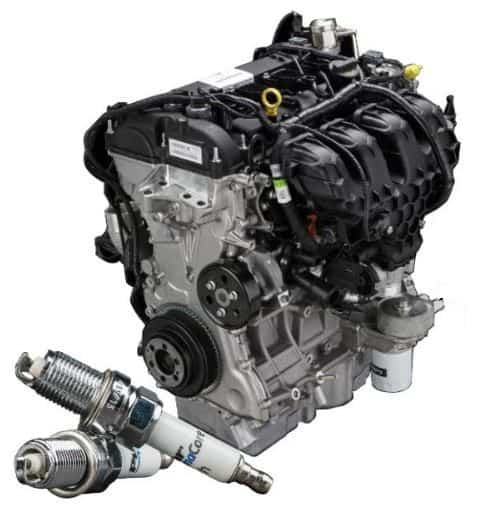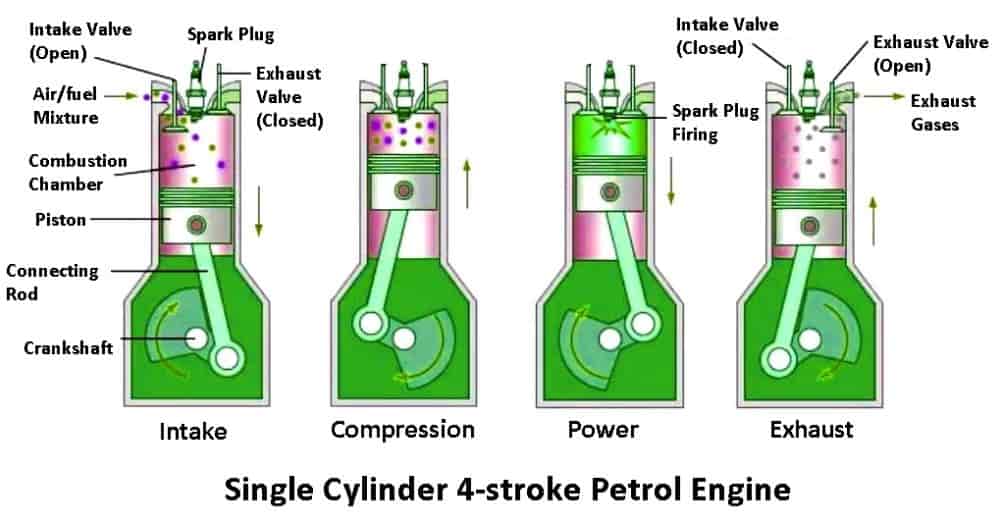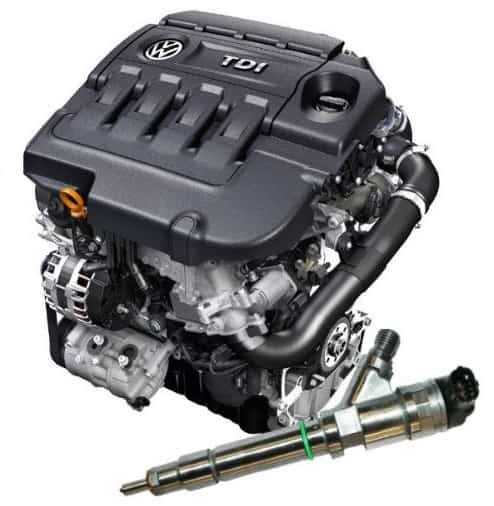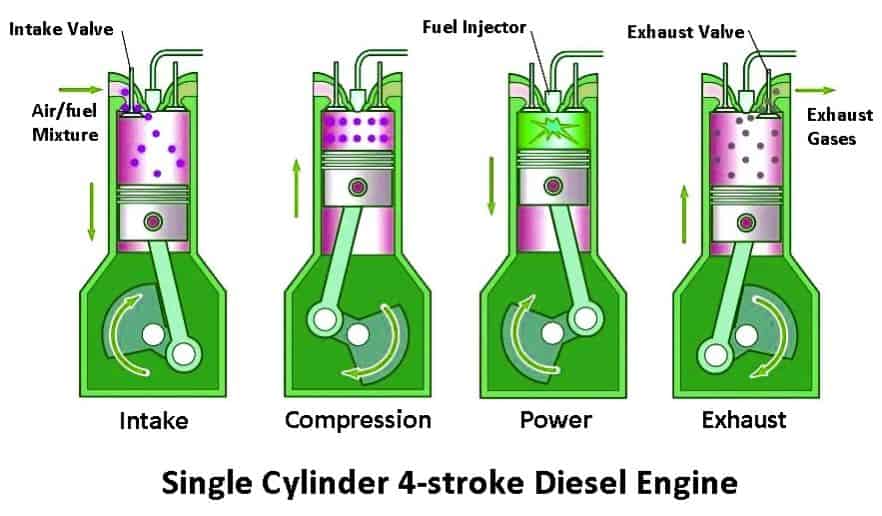Hello readers! In this post, we’ll discuss the difference between petrol and diesel engines using illustrations.
An engine is a device with moving parts that transform one or more forms of energy into mechanical energy. The engines in cars, trucks, buses, and other vehicles are powered by fossil fuels.
The engine can be divided into the following types according to the fuel it uses as its source of power: steam engine, diesel engine, and petrol engine. The majority of automobiles have either petrol or diesel engines.
The main difference between petrol and diesel engines is that a petrol engine uses a spark to compress fuel and air, whereas a diesel engine only compresses air and injects fuel into it. Petrol and diesel engines use the Otto cycle and diesel cycle, respectively.
In this article, we will look at the significant differences between petrol and diesel engines, considering various parameters such as working principle, fuel-air mixing, ignition, power, applications, and so on. But before we get into the specifics, we’ll go over the fundamentals of diesel and petrol engines to understand the differences.
You might like: The Complete List of Car Engine Parts: Its Function (Pictures)
What is a Petrol Engine?
A petrol engine is a type of internal combustion (IC) engine that is commonly used in small vehicles. An electric spark arc ignites the fuel in the petrol engine using spark-ignition technology.

In 1876, a German engineer named Nicolaus August Otto created the first practical petrol engine. The petrol engine operates using the Otto cycle, which bears the name of its creator. There are two isochoric processes and two isentropic processes in the Otto cycle.
As we all know, air is required for fuel combustion. In a gasoline engine, the fuel (gasoline) and air are combined before compression.
A carburetor refers to the component of a petrol engine where fuel and air are combined. Once the fuel and air have been thoroughly combined, the mixture is ejected into the engine cylinder, where a piston compresses it, and an electric spark ignites it.
In this manner, the chemical energy of petrol fuel is transformed into mechanical energy by a petrol engine. Lightweight, high-speed vehicles like cars, bikes, etc., are typically powered by petrol engines.
You might like: Different Types of Engines and Their Working Explained (Images)
Working of Petrol Engine
In a four-stroke engine, a connecting rod connects the pistons to the rotating crankshaft. The four-stroke cycle, by which the piston moves up or down the cylinder every four strokes, is how engines generate power.
According to the image below, the working of a petrol engine can be expressed by the following four steps.

Step 1: The Intake Stroke
Air and fuel enter the combustion chamber of an engine during the intake stroke. However, the method used for this initial step varies depending on the engine type.
Step 2: The Compression Stroke
As the intake valve closes, the combustion chamber is sealed. The first complete revolution of the crankshaft causes the piston to be driven upward, compressing the fuel and air mixture.
Step 3: The Power Stroke
An air-fuel mixture ignited by a spark plug expands quickly via combustion, which causes a piston to retract back into the cylinder once ignited.
Step 4: The Exhaust Stroke
Finally, the exhaust valve opens, and the piston rises one final time, forcing the exhaust gas out of the cylinder as it coats the interior with fresh oil.
Advantages of Petrol Engines
- In general, petrol engines are more powerful than diesel in terms of horsepower.
- The fact that petrol engines are simpler to tune and tune up naturally benefits them.
- It has a better price-to-power ratio and burns fuel more effectively than diesel.
- Typically, petrol is less expensive than diesel.
Disadvantages of Petrol Engines
- Typically, a petrol engine’s lifespan is much shorter than a diesel engine’s.
- The residual (resale) value of diesel engines is typically higher.
- Petrol engines often achieve lower miles per gallon compared to their diesel counterparts.
You might like: What is Anti-lock Braking System?
What is a Diesel Engine?
Diesel engines are another type of internal combustion (IC) engine used to power relatively large machines and automobiles. The term “compression-ignition engine” is also used to describe the diesel engine.

In the 1890s, a German thermal engineer named Rudolf Christian Karl Diesel developed the diesel engine. Based on the diesel cycle, a diesel engine runs. The diesel cycle consists of three processes: continuous pressure, constant volume, and two isentropic processes.
When using a diesel engine, the fuel (diesel oil) is injected into a combustion chamber and ignited by hot, compressed air blown into the chamber. Due to adiabatic compression, the air is extremely hot. As a result, the fuel is not compressed in a diesel engine; instead, only air is.
The spontaneous ignition of diesel fuel in the combustion chamber occurs in the diesel engine. The diesel engine runs at low speeds. Typically, it is used to power heavy machinery and automobiles like buses, trucks, generators, etc.
You might like: How Does A Fuel Injection System Work? [PDF]
Working of Diesel Engine
Initially, intake manifold air enters the cylinder through the inlet port as the piston shifts from TDC to BDC.
Note: The piston creates a vacuum inside the cylinder when it moves from TDC to BDC. As a result, air enters the cylinder due to the pressure difference between the intake manifold and the cylinder.
A diesel engine operates on the diesel cycle. It is explained by the steps shown in the figures below:

Step 1: The Intake Stroke
At the beginning of this intake stroke, the inlet valve is open and closes at the end. The piston begins to move from BDC to TDC after the intake stroke is complete. The piston moves, increasing the air pressure inside the cylinder to a high level.
Step 2: The Compression Stroke
Both the inlet and exhaust valves are closed during compression. The fuel injector sprays fuel inside the cylinder after the air is compressed, which causes the fuel to ignite (catch fire).
Thus, when combustion begins, high-pressure gases inside the cylinder spread out and push the piston downward (in the direction of BDC).
Step 3: The Power Stroke
Both valves (inlet and exhaust) are closed during the power stroke. The power stroke allows the engine to produce power. Therefore, a power stroke is also referred to as an expansion stroke. The piston shifts from BDC to TDC after the expansion stroke.
Step 4: The Exhaust Stroke
When the piston moves from BDC to TDC, burned exhaust gases are released into the atmosphere through the engine exhaust pipe.
As the exhaust stroke proceeds, only the exhaust valve is open, and as the exhaust valve closes, the inlet valve opens to draw fresh air into the engine.
Advantages of Diesel Engine
- Diesel typically has fuel efficiency that is between 25 and 30% better than comparable gasoline engines.
- Since diesel engines lack distributors and spark plugs, they never require ignition tune-ups.
- Diesel engines are built tougher to withstand higher compression to last longer and perform.
- Compared to electric or hybrid vehicles, diesel engines offer better fuel efficiency without the hassle.
Disadvantages of Diesel Engine
- Diesel fuel frequently costs more than regular petrol.
- Due to their more advanced technological design, diesel engine repairs are more expensive than their gas-powered counterparts.
- Although diesel fuel is more effective, it cannot deliver high-speed performance.
- Compared to gasoline-powered vehicles, diesel vehicles are more expensive to buy.
You might like: Understand The 6 Different Types of Turbochargers
Difference Between Petrol and Diesel Engines
Both the diesel engine and the petrol engine are internal combustion engines. However, there are several differences between them, which are listed in the table below:
| The Difference Based On | Petrol Engine | Diesel Engine |
|---|---|---|
| Definition | A petrol engine is an internal combustion engine that ignites the fuel using spark-ignition technology. | A diesel engine is an internal combustion engine that ignites the fuel using compression-ignition technology. |
| Working Cycle | The petrol engine operates on the Otto cycle. | The diesel engine operates on the diesel cycle. |
| Major Components | The engine cylinder, piston, spark plug, carburetor, and intake and exhaust valve are the essential components of a petrol engine. | The combustion chamber and cylinder, fuel injector, piston, intake, and exhaust valve are the essential components of a diesel engine. |
| Method of Ignition | The petrol engine uses an electric spark plug to generate an electric arc that ignites the fuel. | In a diesel engine, the high temperature of hot, compressed air ignites the fuel. |
| Air-fuel mixing | A carburetor is used in petrol engines to combine the fuel and air before introducing them to the engine cylinder. | The air and fuel are mixed inside the engine cylinder of a diesel engine. There is no carburetor in diesel engines. |
| Fuel volatility | Petrol engines run on highly volatile fuels such as petrol. | Diesel engines operate on low-volatility fuels. |
| Consumption of Fuel | Petrol engines require more fuel to generate the same amount of power. | Diesel engines use less fuel than other engines. |
| Engine Weight | A petrol engine is lightweight. | Diesel engines weigh a lot. |
| Starting Price | An initial investment in a petrol engine is lower. | A diesel engine is expensive to purchase new. |
| Maintenance | Regular maintenance is needed for petrol engines. | Less frequent maintenance is needed for diesel engines. |
| Cost of Maintenance | Petrol engines are inexpensive to maintain. | Diesel engines are expensive to maintain. |
| Power Produced | A petrol engine generates comparatively less power. | A diesel engine generates a lot of power. |
| Compression Ratio | A petrol engine has a relatively low compression ratio. | There is a high compression ratio in diesel engines. |
| Thermal Efficiency | A typical petrol engine has a thermal efficiency of about 26%. | A diesel engine has a thermal efficiency of about 40%. |
| Starting | Petrol engines have a low compression ratio, making them easy to start. | Due to its high compression ratio, diesel engines require a little more effort to start. |
| Speed | Petrol engines generally have high speeds. | Diesel engines generally have low speeds. |
| Noise & Vibrations | Petrol engines tend to be quieter and vibrate less. | Diesel engines are very noisy and vibrate a lot. |
| Environment-related Effects | Petrol engines produce relatively fewer environmental pollutants. | Diesel engines pollute the environment quite a bit. |
| Availability of Torque | The petrol engines have a limited amount of available torque. | Diesel engines have a comparatively high torque output. |
| Applications | Petrol engines are generally used in light vehicles like bikes, cars, etc. | Diesel engines are used in heavy vehicles like buses, trucks, trains, etc. |
Wrapping It Up
Internal combustion engines are found in both petrol and diesel vehicles. Both engines have a four-stroke combustion cycle. However, they have different structures and roles. A diesel engine uses compression, while a petrol engine uses spark plugs.
It is clear that the examples provided above also differ in terms of their properties and functions. It is generally considered that gasoline vehicles are more affordable, quieter, and require fewer repairs and maintenance. Unlike gasoline-powered cars, diesel vehicles are more fuel-efficient and have a longer life cycle.
That’s it. Thanks for reading. I hope I have covered everything about the “Difference Between Petrol and Diesel Engines” It would be helpful if you could let me know if there was anything I missed or if you have any doubts about anything I wrote.
Please share this article with your friends if you find it interesting.
Want free PDFs direct to your inbox? Then subscribe to our newsletter.
Download PDF of this article:
Here are some articles you might like to read:
- Different Types of Superchargers
- What is the function of a Starter Motor in an Engine?
- How does a Multi-plate Clutch work?
- Understand The Working of Single Cylinder Engine
- Everything You Need To Know About The Hydraulic Brakes
- How does A Car Thermostat work? Its Symptoms & Replacement
- What are the warning symbols of a car dashboard?
Frequently Asked Questions
Diesel and Petrol engines differ primarily in that Petrol engines use Otto cycles while Diesel engines use Diesel cycles. Some other differences can be attributed to the engines’ structure, types, and applications.
Diesel engines typically last longer than petrol ones because they require less energy to power the engine. You will be able to get a better return on investment with a diesel engine car as compared to a petrol engine car.
Diesel has a higher base price than petrol. But because it is also used by trucks and buses, farmers, and other users, diesel has always been less expensive.
Compared to petrol, diesel has a higher energy rating. Diesel produces more energy per unit of volume than petrol does. Petrol contains 34.8 MJ of energy per litre, while diesel contains 38.6 MJ.
I’m very happy to have all this information from you. Thank you may God bless you.
You’re welcome.